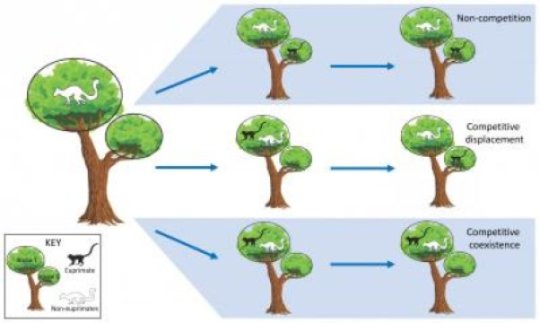[ad_1]
Since Darwin first laid out the basic principles of evolution by means of natural selection, the role of competition for food as a driving force in shaping and shifting a species’ biology to outcompete its adversaries has played center stage. So important is the notion of competition between species, that it is viewed as a key selective force that resulted in the split of the lineage leading to modern humans from that of our early ape ancestors.
The earliest true primates, called “euprimates,” lived about 55 million years ago across what is now North America. Two major fossil euprimate groups existed at this time: the lemur-like adapids and the tarsier-like omomyids. Dietary competition with other similarly adapted mammals was presumably equally critical in the origin and diversification of these two groups. Though it’s been hinted at, the exact role of dietary competition and overlapping food resources in early adapid and omomyid evolution has never been directly tested.
New research published online today in the Proceedings of the Royal Society B -Biological Sciences led by Laura K. Stroik, an assistant professor of biomedical sciences at Grand Valley State University, and Gary T. Schwartz, associate professor and research scientist at Arizona State University’s Institute of Human Origins, confirms the critical role that dietary adaptations played in the survival and diversification of North American euprimates.
“Understanding how complex food webs are structured and the intensity of competition over shared food resources is difficult enough to probe in living communities, let alone for communities that shared the same landscape nearly 55 million years ago,” said Stroik.
The researchers utilized the latest in digital imaging and microCT scanning on more than 350 fossil mammal teeth from geological deposits in North America. They sought to quantify the 3D surface anatomy of molars belonging to extinct representatives of rodents, marsupials, and insectivores — all of which were found within the same geological deposits as the euprimates and were thus likely real competitors.
The high-resolution scans allowed them to capture and quantify details of how sharp, cresty, or pointy the teeth were. In particular, they looked at molars, or the teeth at the back of the mouth, useful in pulverizing and crushing food or prey. The relative degree of molar sharpness is directly linked to the broad menu of dietary items consumed by each species.
Stroik and Schwartz used these aspects of molar anatomy to compute patterns of dietary overlap across some key fossil groups through time. These results were then weighed against predictions from three models of how species compete with one another drawn from the world of theoretical ecology. The signal was clear: lineages belonging to the adapids largely survived and diversified without facing competition for food. The second major group, the omomyids, had to sustain periods of intensive competition with at least one contemporaneous mammal group. As omomyids persisted into more recent geological deposits, it is clear that they evolved adaptive solutions that provided them with the ability to compete and were usually victorious.
“The results showed adapids and omomyids faced different competitive scenarios when they originated in North America,” said Stroik.
“Part of what makes our story unique is that for the first time we compared these fossil euprimates to a range of potential competitors from across a diverse group of mammals living right alongside adapids and omomyids, not just to other euprimates,” said Schwartz. “Doing so allowed us to reconstruct a far greater swath of the ecological landscape for these important early primate relatives than has ever been attempted previously.”
The key advance of this new research is the demonstration that diet did in fact play a fundamental role in the establishment, and continued success, of euprimates within the North American mammalian paleocommunity. An exciting outcome is the development of a new quantitative toolkit to diagnose patterns of dietary competition in past communities. This will now allow them to explore the role that diet and competition played in how some of these fossil euprimates continued to evolve and diversify to give rise to living lemurs and all other higher primates.
Story Source:
Materials provided by Grand Valley State University. Note: Content may be edited for style and length.
[ad_2]















